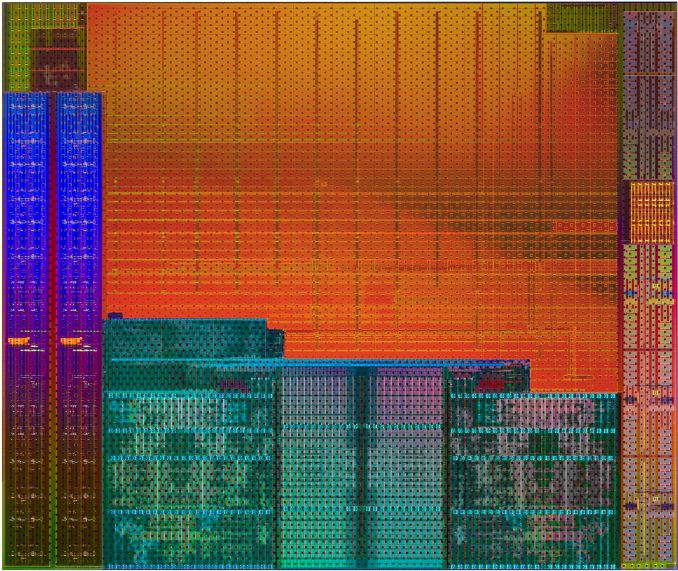
Original Link: https://www.anandtech.com/show/8119/amd-launches-mobile-kaveri-apus
AMD Launches Mobile Kaveri APUs
by Jarred Walton on June 4, 2014 12:01 AM EST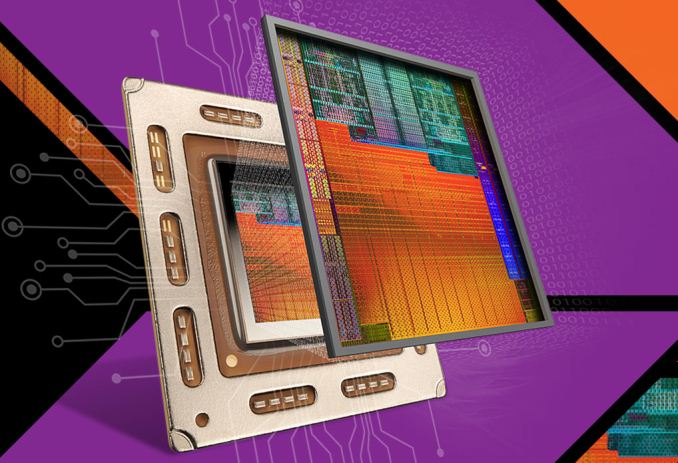
Introducing AMD's Mobile Kaveri APUs
A couple weeks back, AMD flew us out to San Francisco for a briefing on their upcoming Mobile Kaveri APUs. Along with the briefing, we were given some time to run benchmarks on a prototype Kaveri laptop, though I'll note up front that the laptop isn't intended for retail and is merely a demonstration of performance potential. A funny thing happened about a week after the briefing, which some of you likely saw: AMD's web team accidentally posted all of the specs for the upcoming mobile Kaveri APUs ahead of schedule (for about half a day). We removed our coverage of the Mobile Kaveri APUs when AMD corrected the error, but we might as well jump right into things with the overview of the new mobile APUs.
Kaveri is AMD’s latest generation high-performance APU, and appeared first released on the desktop back in January of this year. We were a bit surprised – perhaps even perplexed – about the desktop first launch, considering AMD's "we're not going after the highest performance CPU market" stance. Then again, AMD-equipped laptops haven't been as strong as Intel-equipped laptops – not that the APUs aren't fast enough, but getting OEM partners to make a compelling AMD laptop seems rather difficult. As the saying goes, "You can lead a horse to water but you can't make him drink." AMD has provided a compelling APU and platform solution for a couple years, but the perception is that AMD platforms are budget platforms, so basically almost every corner gets cut. I'll have more to say on that later, but it's still a major concern in my book. Regardless, since the desktop Kaveri launch we have been eagerly awaiting the release of the mobile incarnation.
The launch has been scheduled for H1 2014 for some time now, and with AMD able to offer significant GPU performance with their APUs coupled with the space benefits of an integrated GPU versus a discrete GPU, it should be an easy sell. Mobile of course is not without its challenges. Power use is paramount, and while AMD has always been able to meet the desired TDPs, there is often the matter of performance tradeoffs required to hit those TDPs. Mobile is also a highly contested market right now; Intel of course has their Bay Trail and Haswell parts, but we're now seeing tablets and ARM-based Chromebooks pushing into AMD territory.
Despite the somewhat questionable decision to launch first on desktop – particularly odd given both Llano and Trinity launched more or less simultaneously on laptops and desktops – it's now time to pull the wrappings off Kaveri for the second time and see what AMD has created. We're now almost exactly a year after the launch of mobile Richland, which was really just a minor tweak of Trinity that launched about two years back. This is the first major architectural upgrade for AMD laptop APUs in two years, and expectations and hopes are high.
Kaveri brings a number of improvements, including the higher performance Steamroller based CPU cores and modern GCN based GPUs. We've previously covered this material, so rather than rehash things on the mobile side I'll simply refer back to the desktop Kaveri launch information. (You can also view the full presentation deck in the above gallery if you're interested.) AMD's Kaveri will be going up against Intel’s existing Haswell products, and this is AMD’s best chance to claw back market share from the Haswell family. Of course AMD has other APUs as well – specifically, Beema/Mullins will target the ultra-low power and tablet markets – but those compete in an even lower price bracket and go up against Intel's Bay Trail offerings. For now, let's start with an overview of the new Mobile Kaveri APUs.
AMD Mobile Kaveri SKUs
The previous generation Trinity/Richland APUs came in four variants: at the top were the highest performance 35W TDP standard voltage (SV) parts, and then we dropped into the ultra-low voltage (ULV) range with several variations: 25W, 19W, and 17W TDPs were all available. With Kaveri, AMD is mostly consolidating their lineup into two classes: SV 35W TDP parts, and ULV 19W TDP parts. AMD did mention at one point that the 19W parts can be configured to target different TDPs, however, allowing the laptop OEM to target anywhere from 15W to 25W if desired. There's also at least one 17W TDP part, which we'll get to in a moment.
One other item that AMD emphasized was their new idea of "Compute Cores", which is a way for them to compare performance potential of CPU and GPU cores. GPUs typically have hundreds of cores that are good for very specific tasks whereas CPUs have a few cores that are general purpose, but the GPU functionality is becoming increasingly complex so AMD wanted a way to compare them. For the purposes of Kaveri (and GCN graphics cards), AMD has defined a Compute Core as being "any core capable of running at least one process in its own context and virtual memory space, independently from other cores." What that means is each GCN Compute Unit counts as a Compute Core, and each CPU thread (two per Steamroller module) counts as a Compute Core.
|
AMD 35W Standard Voltage Mobile APUs
|
||||||
|
Trinity
|
Richland
|
Kaveri
|
||||
| Model | A10-4600M | A8-5557M | A10-5757M | A8-7200P | A10-7400P | FX-7600P |
| Core Name | Trinity | Richland | Richland | Kaveri | Kaveri | Kaveri |
| Microarch | Piledriver | Piledriver | Piledriver | Steamroller | Steamroller | Steamroller |
| Modules/Cores | 2/4 | 2/4 | 2/4 | 2/4 | 2/4 | 2/4 |
| CPU Base Freq | 2300 | 2100 | 2500 | 2400 | 2500 | 2700 |
| Max Turbo | 3200 | 3100 | 3500 | 3300 | 3400 | 3600 |
| TDP | 35W | 35W | 35W | 35W | 35W | 35W |
| L1 Cache |
128KB I$ 64 KB D$ |
128KB I$ 64 KB D$ |
128KB I$ 64 KB D$ |
192 KB I$ 64 KB D$ |
192 KB I$ 64 KB D$ |
192 KB I$ 64 KB D$ |
| L2 Cache | 2x2MB | 2x2MB | 2x2MB | 2x2MB | 2x2MB | 2x2MB |
| Graphics | HD 7660G | HD 8550G | HD 8650G | R5 | R6 | R7 |
| GPU Cores | 384 | 256 | 384 | 256 | 384 | 512 |
| GPU Clock | 685 | 720 | 720 | 626 | 654 | 686 |
| Max DDR3 | 1600 | 1600 | 1600 | 1866 | 1866 | 2133 |
Starting at the top with the 35W APUs, these will be the highest performance mobile parts. At launch there will be three 35W APUs: the "entry" A8-7200P, "mainstream" A10-7400P, and "enthusiast" FX-7600P. All three APUs use the P suffix to indicate that they’re 35W parts. And right away, we see some interesting changes from the Trinity/Richland lineup.
First, you're sure to notice the use of the FX branding. Make no mistake: this is the same APU as the other Kaveri parts and it has no relation to the desktop FX processors; AMD marketing simply feels the FX brand has a good reputation among enthusiasts and consumers and they wanted to carry that over into the mobile world. Of course this also solves the question of what to call the new highest-end APU; Llano had A4/A6/A8 while Trinity used A6/A8/A10; Kaveri will use A6/A8/A10/FX (so no A12 for now; sorry).
Looking at the core clocks, the base clocks haven't changed too much (2.4-2.7GHz with Kaveri compared to 2.1-2.5GHz on Richland), but Turbo Core clocks have gone up quite a bit. AMD noted that a lot of work went into tuning the mobile Kaveri APUs for power, with one of only four Corporate Fellows at AMD being in charge of that area. The result is that Kaveri should run closer to its Turbo clock in many situations, and the maximum clock speeds have increased from 3.0-3.5GHz on Trinity/Richland to 3.3-3.6GHz on Kaveri. That might not seem like a big deal at first, but keep in mind a couple of points. First, at the same clock speed the Steamroller cores in Kaveri should be about 15-20% faster than the Piledriver cores in Trinity/Richland, thanks to architectural improvements. Second, on the desktop Richland actually topped out at 4.1/4.4GHz while Kaveri only reaches 3.7/4.0GHz, so while Kaveri still enjoys architectural improvements it had to be clocked slower; we don’t see that with the mobile parts.
AMD's Joe Macri (Corp VP and Product CTO Global Business Unit) discussed some of the design decisions that went into Kaveri, noting that choosing the right type of transistor for an APU is different than building a pure CPU. At a high level, there are “V” shaped transistors frequently used with CPUs that can run at higher clock speeds, and “T” shaped transistors that tend to work better in the highly parallel design of GPU cores. From what I could gather, AMD used "V" transistors in Trinity/Richland but has switched to "T" transistors for Kaveri, which explains the drop in maximum clock speed. Joe also noted that 47% of the Kaveri core is dedicated to GPU, again highlighting the importance of the transistor choice.
Moving over to the GPU side of things, each of the 35W APUs comes with a different GPU configuration, using 256, 384, or 512 stream processors for the A8/A10/FX parts, respectively. GPU clock speeds top out at 686MHz with Kaveri compared to 720MHz with Richland, so this is another small step back but GCN’s architectural efficiency and increase in SPUs in the FX-7600P should more than compensate. That said, feeding these increasingly powerful GPUs becomes an increasingly difficult task, which is why maximum memory clock speeds are up to 1866MHz for the A8 and A10, and meanwhile the FX processor goes one further to 2133MHz. Given just how hard it is to feed a fully enabled APU like the FX-7600P – a problem we’ve already seen on the similarly configured desktop SKUs – the memory bandwidth increase is a welcome sight.
|
AMD 17W Ultra-Low Voltage Mobile APUs
|
||||
|
Trinity
|
Richland
|
Kaveri
|
||
| Model | A4-4455M | A4-4145M | A6-5345M | A6-7000 |
| Core Name | Trinity | Richland | Richland | Kaveri |
| Microarch | Piledriver | Piledriver | Piledriver | Steamroller |
| Modules/Cores | 1/2 | 1/2 | 1/2 | 1/2 |
| CPU Base Freq | 2100 | 2000 | 2200 | 2200 |
| Max Turbo | 2600 | 2600 | 2800 | 3000 |
| TDP | 17W | 17W | 17W | 17W |
| L1 Cache |
128KB I$ 64 KB D$ |
128KB I$ 64 KB D$ |
128 KB I$ 64 KB D$ |
192 KB I$ 64 KB D$ |
| L2 Cache | 2MB | 1MB | 1MB | 1MB |
| Graphics | HD 7500G | HD 8130G | HD 8410G | R4 |
| GPU Cores | 256 | 128 | 192 | 192 |
| GPU Clock | 424 | 554 | 600 | 553 |
| Max DDR3 | 1333 | 1333 | 1333 | 1600 |
|
AMD 19W Ultra-Low Voltage Mobile APUs
|
|||||
|
Trinity
|
Richland
|
Kaveri
|
|||
| Model | A8-4555M | A8-5545M | A8-7100 | A10-7300 | FX-7500 |
| Core Name | Trinity | Richland | Kaveri | Kaveri | Kaveri |
| Microarch | Piledriver | Piledriver | Steamroller | Steamroller | Steamroller |
| Modules/Cores | 2/4 | 2/4 | 2/4 | 2/4 | 2/4 |
| CPU Base Freq | 1600 | 1700 | 1800 | 1900 | 2100 |
| Max Turbo | 2400 | 2700 | 3000 | 3200 | 3300 |
| TDP | 19W | 19W | 19W | 19W | 19W |
| L1 Cache |
128KB I$ 64 KB D$ |
128KB I$ 64 KB D$ |
192 KB I$ 64 KB D$ |
192 KB I$ 64 KB D$ |
192 KB I$ 64 KB D$ |
| L2 Cache | 2x2MB | 2x2MB | 2x2MB | 2x2MB | 2x2MB |
| Graphics | HD 7600G | HD 8510G | R5 | R6 | R7 |
| GPU Cores | 384 | 384 | 256 | 384 | 384 |
| GPU Clock | 424 | 554 | 514 | 533 | 553 |
| Max DDR3 | 1333 | 1333 | 1600 | 1600 | 1600 |
Moving on to the 17W/19W parts, there's apparently a single 17W APU, the A6-7000, along with three 19W APUs. (AMD didn't provide details on the A6-7000 at the briefing, but we've since confirmed the above specifications, and there's also a Pro equivalent -- see below.) Richland had two 17W parts and one 19W part, so AMD has sort of flipped roles here. As expected the 17W A6-7000 is a rather lean chip; it has one Steamroller module and 192 GCN steaming processors (for a total of five Compute Cores, if you're counting), with a base/turbo CPU clock speed of 2.2GHz/3.0GHz while the GPU turbo clock stands at 553MHz. Compared to the previous generation Richland processors, the A6-7000 gains all of Kaveri’s architectural improvements along with an additional 200MHz for the maximum CPU turbo clock. GPU clock speeds on the other hand take a hit, but this is offset by GCN’s greater performance and a badly needed increase in the maximum DDR3 memory clock speed. In fact with mobile Kaveri, DDR3-1600 is now the baseline, with all processors supporting 1600 or better.
Meanwhile the 19W parts all have two Steamroller modules, and maximum base/turbo clock speeds only differ by 300MHz; most of the differentiation comes in the GPU department. The A8-7100 includes four GCN CUs, the A10-7300 has six CUs with slightly higher GPU clocks, and the FX-7500 also has six CUs with another moderate bump in clock speed. AMD has also brought along the "R-series" branding for the GPUs, so the A6-7000 gets an R4 GPU, the A8 is an R5, A10 gets an R6, and the FX has an R7 GPU. Maximum GPU clocks are again down in some cases compared with Richland, though architectural difference should more than cover any loss in clock speed.
|
AMD 17/19W Commercial Pro Series ULV APUs
|
|||
| Model | A6 Pro-7050B | A8 Pro-7150B | A10 Pro-7350B |
| Core Name | Kaveri | Kaveri | Kaveri |
| Microarch | Steamroller | Steamroller | Steamroller |
| Modules/Cores | 1/2 | 2/4 | 2/4 |
| CPU Base Freq | 2200 | 1900 | 2100 |
| Max Turbo | 3000 | 3200 | 3300 |
| TDP | 17W | 19W | 19W |
| L1 Cache |
192 KB I$ 64 KB D$ |
192 KB I$ 64 KB D$ |
192 KB I$ 64 KB D$ |
| L2 Cache | 1MB | 2x2MB | 2x2MB |
| Graphics | R4 | R5 | R6 |
| GPU Cores | 192 | 384 | 384 |
| GPU Clock | 533 | 533 | 553 |
| Max DDR3 | 1600 | 1600 | 1600 |
There's one final category of APUs, which appear to be AMD's equivalent of Intel's SIPP (Stable Image Platform Program) CPUs: the AMD Pro Series. There are three Pro APUs, the A10 Pro-7350B, A8 Pro-7150B, and A6 Pro-7050B. These APUs are functionally equivalent to the FX-7500, A10-7300, and A6-7000 respectively. The Pro series targets business customers with a message of commercial stability and management. AMD guarantees that these APUs will remain available for an extended period of time, so enterprise customers won't need to worry about validating new hardware for a couple years.
Besides offering different levels of performance, AMD is also differentiating their Kaveri APUs based on other features. Eyefinity and TrueAudio support will be limited to the A10 and FX APUs; the A6/A8 APUs lose this functionality. Similarly, the A6 does not have Dual Graphics functionality; I didn't have much luck with Dual Graphics on Richland/Trinity laptops, but with the iGPU and dGPU both being GCN architectures now there's at least more potential to extract additional performance through CrossFire. Finally, note that the A6 APUs get ARM TrustZone functionality, whereas the higher-end A8, A10, and FX APUs do not.
All of the above was discussed previously (and then pulled), but we have something new to add with today's launch: a performance preview.
AMD Kaveri FX-7600P System/CPU Performance Preview
After the briefing, we were given a chance to benchmark a prototype Kaveri notebook for a few hours. That wasn't enough to run our full suite of laptop benchmarks, and battery testing in particular is something we couldn't perform. I did run some quick simulations of battery life; however, the prototype systems are optimized more for performance rather than power, so the results weren't really meaningful. We'll have to wait for retail laptops with Kaveri APUs before we can really see what sort of battery life to expect, but AMD claims there should be a decent jump in mobility compared to Richland.
The test systems were more of a proof of concept rather than anything you could actually sell. The keyboard was okay if a little mushy, but the touchpad in particular I found a bit lacking, and build quality was mediocre as well. The screens at least were good quality 1080p 15.6" touchscreen panels, and that was enough to get us benchmarking. I snapped a few pictures of the laptop that you can see above. In terms of other core specs, the laptop had 8GB of DDR3-1866 RAM and a Samsung M.2 256GB SSD.
For our purposes here, we're including the AMD Kaveri Prototype, AMD Trinity Prototype, and AMD Kabini Prototype laptops as a starting point. For retail laptops, we have the MSI GX60 with Richland A10-5750M APU (but only a single 8GB SO-DIMM, unfortunately), the Sony VAIO Pro 13 (i5-4200U), and the Acer V7-482PG (i7-4500U + GT 750M). The Acer is the only laptop equipped with a discrete GPU, so we wanted to see how Kaveri stacks up against such a system. You can compare additional results against Kaveri in Mobile Bench, of course.
Again, these numbers are only preliminary – the drivers for the GPU were slightly older (without Mantle support enabled yet), and there were occasions of odd behavior where other editors had scores that didn't match up with our results until after a reboot. We were not able to run each benchmark multiple times, so most of these results are from a single run. AMD is keen to talk about the GPU improvements with Kaveri, but I also wanted to see what has happened on the CPU side, so we'll start with our CPU/system benchmarks.
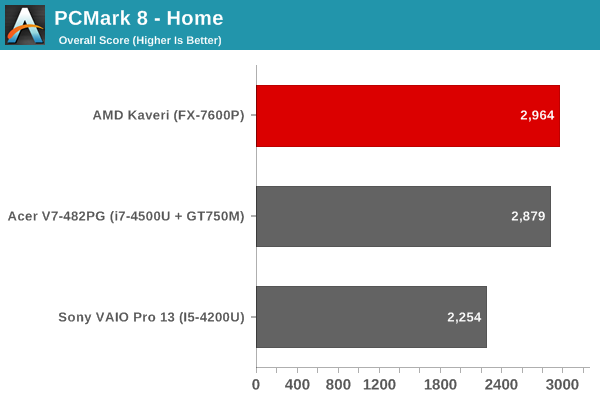
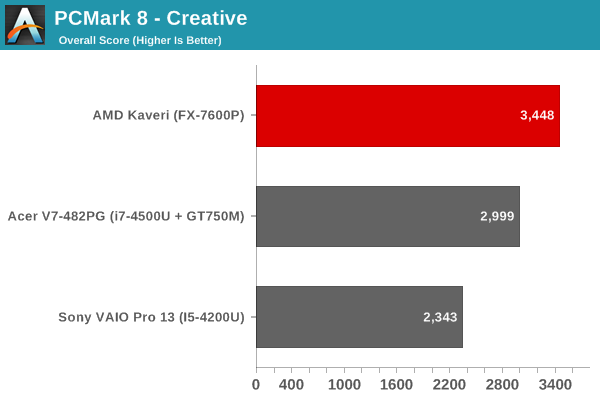
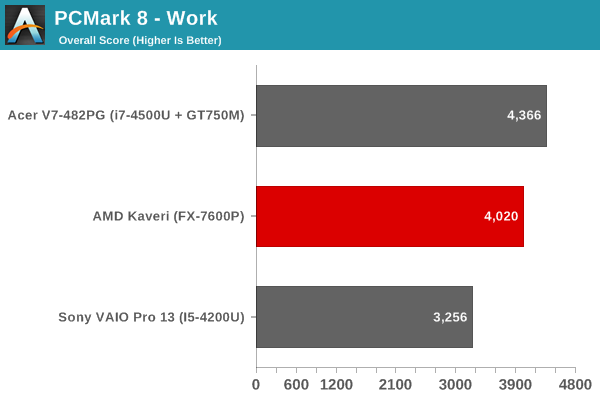
We don't have results for PCMark 8 for many of the systems, and the VAIO Pro 13 seems to be underperforming for some reason, but otherwise we get a pretty good idea of where things fall in terms of overall performance. Note that PCMark 8 is now OpenCL accelerated, which can improve performance quite a bit on AMD APUs. The result is that AMD actually takes the lead in the Home and Creative suites, but without more time benchmarking the system I wouldn't try to draw too many conclusions. Storage subsystem performance can still have an enormous impact on PCMark results, and the V7-482PG has to get by with an SSD caching solution. The VAIO Pro 13 on the other hand just seems to score a bit lower than I'd expect, so again take these scores with a grain of salt.
Moving on to other benchmarks, I also ran PCMark 7 as it doesn't have any OpenCL acceleration and will provide a better view of traditional application performance. Hopefully we'll continue to see improvements in the use of OpenCL (GPU) acceleration and over time PCMark 8 scores will be more indicative of real-world performance, but right now there are plenty of situations where having a GPU does very little for performance.
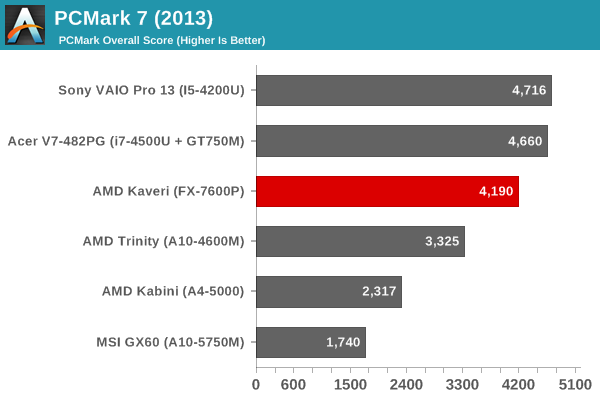
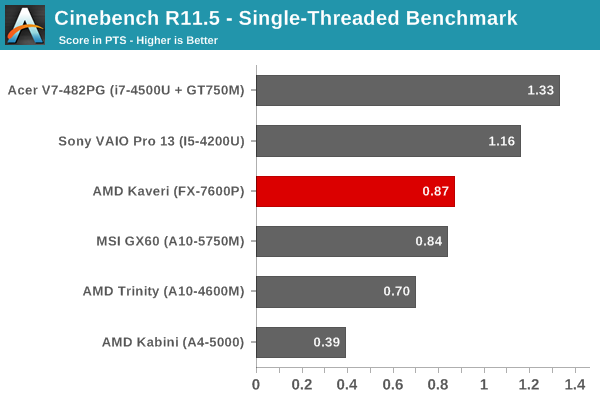
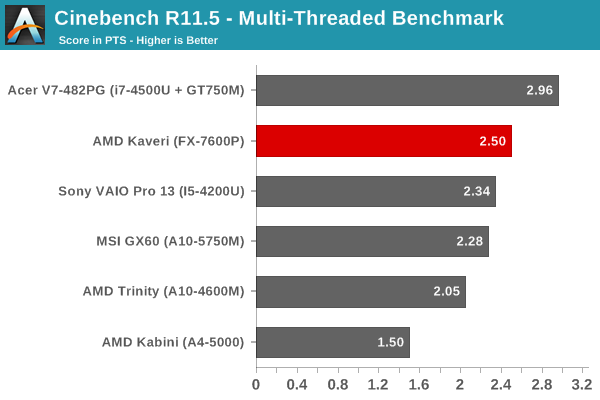
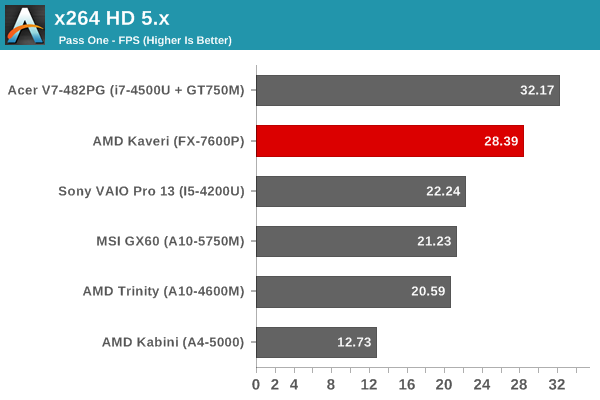
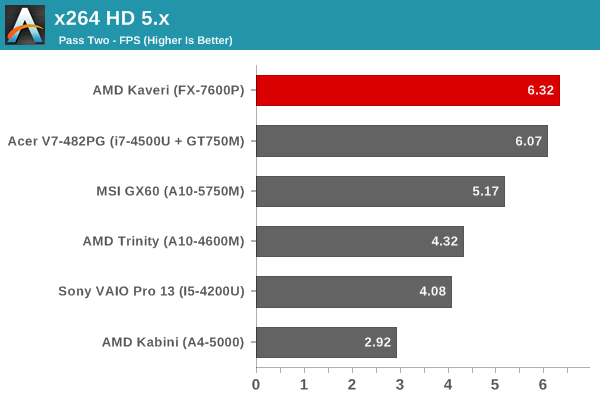
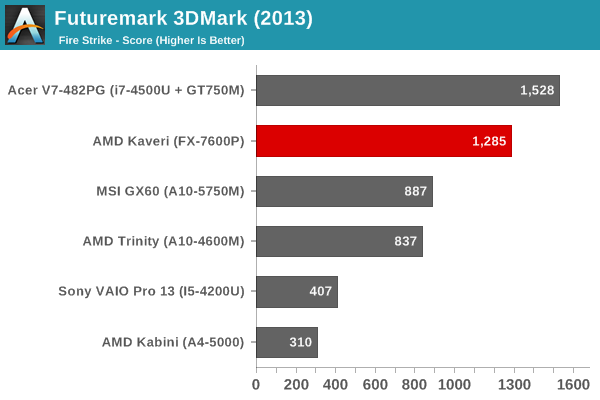
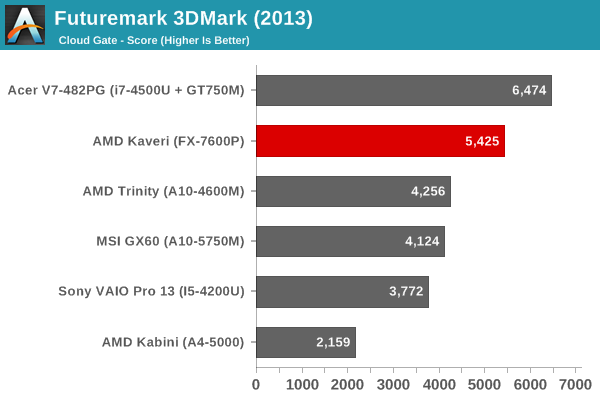
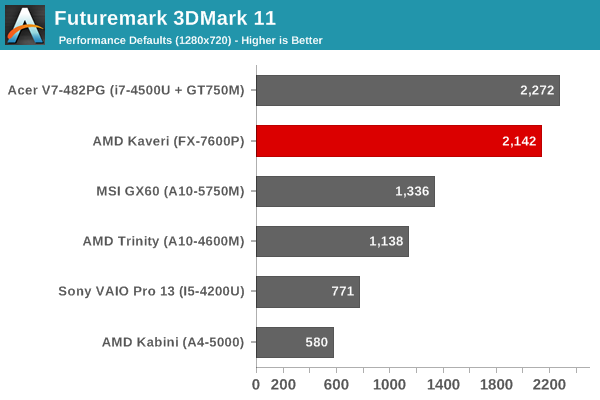
Somewhat surprisingly, Kaveri actually takes the lead in the very demanding second pass of the x264 HD 5.0 encoding test. Granted, we're looking at a 35W APU vs. 15W ULV CPU, and Intel's 37W quad-core parts would certainly retake the lead (and cost quite a bit more), but at least Kaveri is showing some real improvements over Richland in these tests. As noted above, PCMark 7 doesn't have any OpenCL optimizations so the gap between AMD and Intel is a bit wider.
Moving to the 3DMark results, Kaveri shows an impressive increase in performance over the Trinity/Richland GPU, which is expected. Intel's iGPU – particularly in the ULV system shown here – just doesn't stand a chance. While we are potentially TDP limited for the ULV Intel parts in graphics tests, my experience is that 3DMark hits the GPU much more than the CPU, so the GPU gets the lion's share of the TDP. I'll try to run some tests on other Haswell systems using the iGPU to verify the above results, but outside of the HD 5000 and Iris parts, I wouldn't expect Intel's iGPU to be too much faster than what we're seeing here.
Overall, an Intel CPU with a discrete GPU is still faster than Kaveri in most areas, and a quad-core i7-4702QM would really distance itself from AMD's Kaveri…but the quad-core i7 CPUs tend to start at around $350, so there's not much point in discussing that comparison. My personal feeling is that unless you're really pushing a laptop hard, most of the modern CPUs/APUs are plenty fast. I wouldn't want a Kabini APU, but Trinity/Richland, Ivy Bridge, Kaveri, and Haswell are all going to be fine for everyday use.
The more important element for me with a laptop (or desktop) is that I simply can't stand using conventional hard drives for the primary storage device any longer. Given the choice between an AMD Kaveri APU with a 256GB SSD (the Crucial MX100 is sure looking nice!) and pretty much any other laptop that has pure HDD storage, it's a no brainer for me. In fact, laptop manufacturers would do their customers a great service if they took the cost savings of AMD's APU vs. Intel's CPU and put that into a decent SSD solution rather than chasing the lowest possible price!
AMD Kaveri FX-7600P GPU Performance Preview
Given the 3DMark results we just showed as well as the increase in CPU performance, I was very interested to see what Kaveri could do in terms of gaming performance. Here I have to temper my comments somewhat by simply noting that the graphics drivers on the prototype laptops did not appear to be fully optimized. One game in particular that I tested (Batman: Arkham Origins) seemed to struggle more than I expected, and there are other games (Metro: Last Light and Company of Heroes 2) that will bring anything short of a mainstream dGPU to its knees. I've posted the Kaveri Mainstream and Enthusiast scores in Mobile Bench, but they're not particularly useful as most of the scores are below 30 FPS. Here, I'll focus on our "Value" settings, which are actually still quite nice looking (Medium detail in most games).
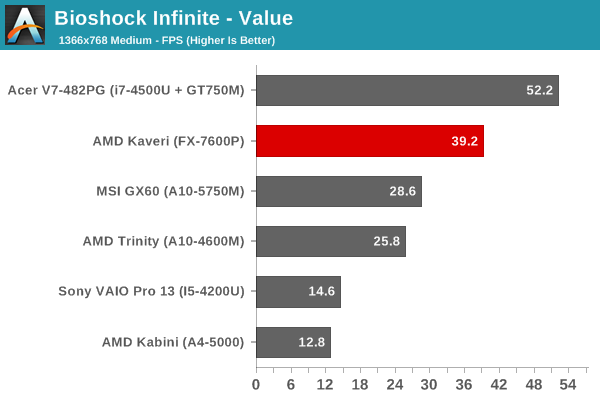
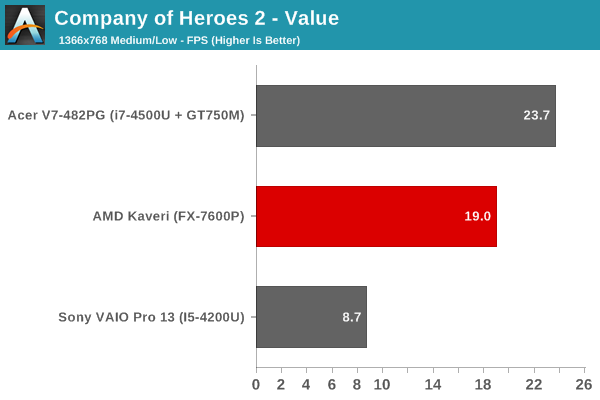
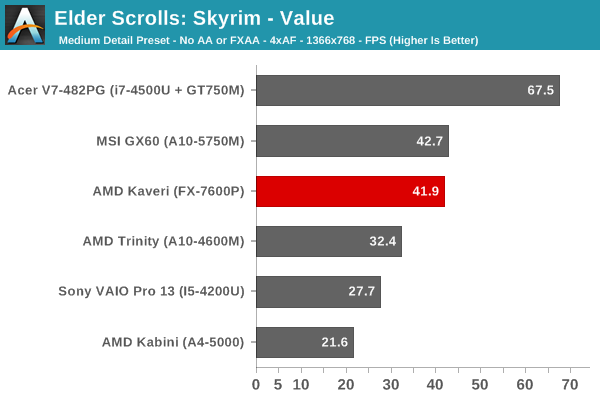
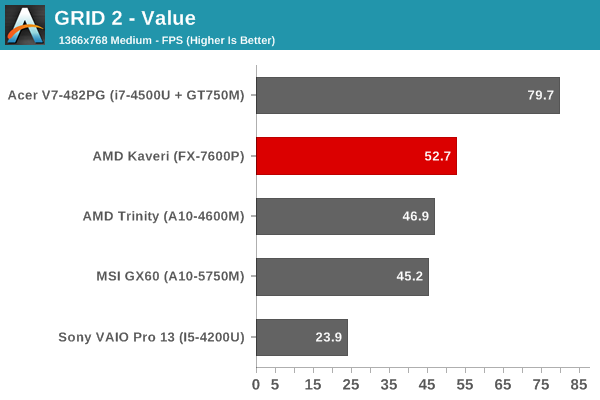
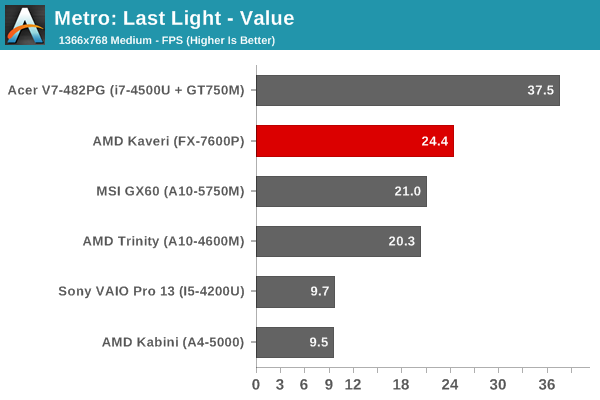
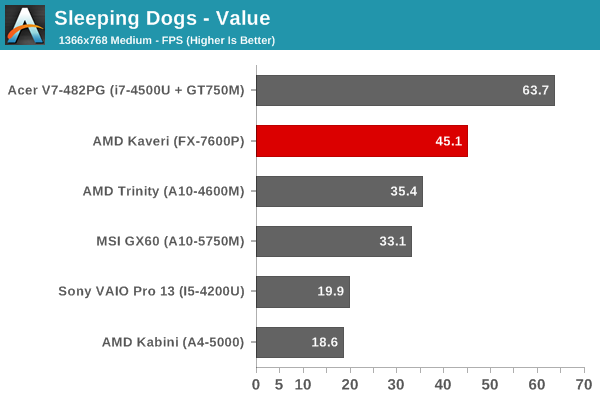
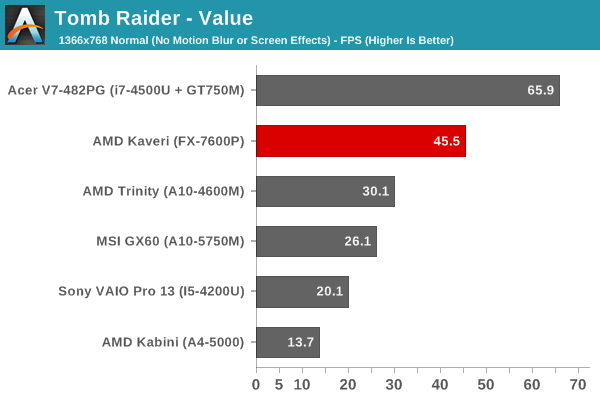
As expected, in most of the tests the Kaveri APU is able to surpass the gaming performance of every other iGPU, and in some cases it even comes moderately close to a discrete mainstream dGPU. There's a sizeable gap between the Trinity/Richland APUs and Kaveri in most of the games I tested, which is great news for those looking for a laptop that won't break the bank but can still run most modern games.
Getting into the particulars, Skyrim seems to be hitting some bottleneck (possibly CPU, though even then I'd expect Kaveri to be faster than Richland), but the vast majority of games should run at more than 30 FPS. There was one system with a pre-release Mantle driver installed that was running Battlefield 4 reasonably well at low/medium details, and with shipping laptops and drivers (and perhaps DDR3-2133 RAM) I suspect even Metro might get close to 30 FPS. Of course, we're only looking at the top performance FX-7600P here, so we'll have to see what the various 19W APUs are able to manage in similar tests.
Initial Thoughts
I really wish Kaveri could have launched on laptops earlier in the year. While Trinity was a decent solution, Richland didn't really offer much in the way of real improvements, and then seeing Kaveri on desktops first and laptops second was more than a little disappointing. The good news is that Kaveri laptops should start shipping in the near future, and overall they offer a good blend of performance and features that should help AMD be more competitive in the growing world of laptop computing.
Our initial performance results look about right, perhaps even a little lower than we'll see from final shipping hardware. There's also plenty of potential for improved performance as more applications start to leverage OpenCL, but AMD has been beating that drum for a while and it's been a relatively slow process. Yes, there are applications that can perform much faster with an APU than with an Intel CPU, but we still need more. It's fine to talk about HSA and Compute Cores, but until they make a tangible difference in every day applications they're mostly talking points. For people that truly need compute performance, I suspect they're looking at much higher performance parts than an APU.
One interesting example AMD discussed was using an optimized JPEG decoder to process images and generate thumbnails in a Windows folder. This is actually something I can see as being useful to a lot of people, and AMD was able to speed up the process by 80% compared to an Intel laptop running the stock Windows JPEG decoder. However, it's not clear how much of that performance increase is AMD being faster than Intel as opposed to the default Windows JPEG decoder simply being slow.
There are some notable omissions in our performance data right now as well. We were only able to test the highest performance Kaveri laptop APU, the FX-7600P, and even that was essentially in "beta" form. I think the 19W FX-7500 will be potentially more interesting, and if AMD is really able to hit close to max turbo speeds most of the time it could prove a potent alternative to Intel's 15W ULV processors. Something else I'm very interested in seeing is what sort of battery life AMD is able to coax out of these APUs, as Llano and Trinity both did quite well – or at least, they did well when the laptop OEM took time to get things right. And that is perhaps the biggest obstacle AMD faces right now: getting their APUs into laptops that don't cut corners in all the wrong places.
As I noted earlier, storage performance (i.e. having a pure SSD solution for the OS and primary applications) is now far more critical for most use cases than the choice of CPU. However, we can't even get $1000+ laptops to universally switch to SSDs, and it's going to be a long row to hoe getting anything priced under $800 to include one. You can just picture the bean counters: "Why are we using a $100 SSD that only holds 256GB instead of a $50 HDD that holds 1TB!? That's a terrible component choice!" On a similar note, getting a laptop with a good keyboard, trackpad, and screen is more difficult than it needs to be even on midrange laptops, and I've seen many an AMD-equipped laptop fall flat on its face thanks to penny pinching and cut corners in these areas. Finally, it's important to note that all batteries are not created equal; while it would be nice if a 56Wh battery was always a 56Wh battery, I know from experience that there's still a wide range of quality, including the ability to store a charge for more than a few weeks without going dead.
But these things cost money, and when you're saving $50-$100 by using an AMD APU instead of an Intel CPU, the mindset often becomes, "Where else can we save money?" The result is a race to the bottom, and if laptop OEMs aren't careful they'll lose more and more market share to alternative devices. (There's a thought: someone make a Kaveri-based Chromebook. That could be interesting!)
Bottom line: AMD's Kaveri APUs show plenty of promise. Now I want someone to build a nice AMD-equipped laptop for under $800 (with or without a ULV APU). Take the core elements of a good Ultrabook, swap out the Intel CPU/platform for an AMD Kaveri APU/platform, and keep the SSD, form factor, and screen. If one of the major OEMs can deliver that sort of product at a lower price than the Intel equivalent, it would be an easy recommendation.

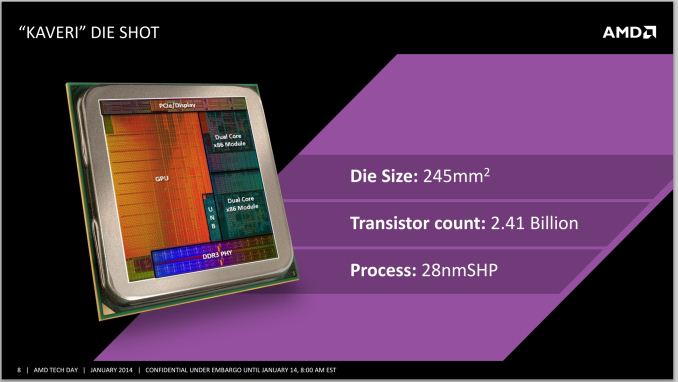
_thumb.png)
_thumb.png)
_thumb.png)
_thumb.png)
_thumb.png)
_thumb.png)
_thumb.jpg)
_thumb.jpg)
_thumb.jpg)
_thumb.jpg)
_thumb.jpg)
